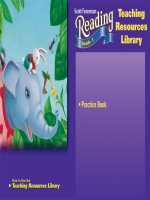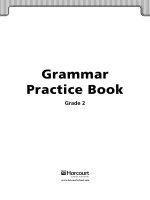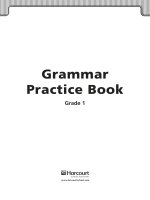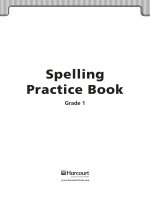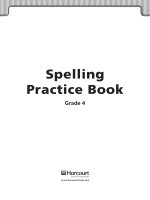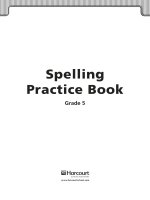raeding practice book grade 3
Bạn đang xem bản rút gọn của tài liệu. Xem và tải ngay bản đầy đủ của tài liệu tại đây (5.05 MB, 242 trang )
Editorial Offices: Glenview, Illinois • New York, New York
Sales Offices: Reading, Massachusetts • Duluth, Georgia • Glenview, Illinois
Carrollton, Texas • Menlo Park, California
Scott Foresman
© Scott Foresman 3
Name _______________________________________________
How I Spent My
Summer Vacation
Sequence 1
Sequence
Notes for Home: Your child read a story and then identified the order in which the story
events occurred. Home Activity: Read a story with your child. Encourage him or her to retell
the story with the events in the appropriate sequence.
• Sequence is the order in which things happen in a story.
• Clue words, such as before and after, can tell you when something happens.
Directions: Reread “First Day at Camp.” Write the story events from the box in the
flow chart in the order that they happen. Two have been done for you.
Story Events
Arnie holds a snake.
Everyone hikes to the cabin.
Everyone takes a nap.
Everyone eats lunch.
Arnie thinks of his mom and Louanne.
Arnie meets Stretch.
Everyone goes on a nature hike.
1.
2.
3.
4.
Everyone goes on a nature hike.
Arnie meets Stretch.
5.
Before LastNext
© Scott Foresman 3
2 Vocabulary
Notes for Home: Your child identified and used vocabulary words from How I Spent My
Summer Vacation. Home Activity: With your child, look at a picture book about the Old West.
Discuss what it would be like to live there, using as many vocabulary words as you can.
Vocabulary
Directions: Write the word from the box that belongs in each
group.
________________ 1. spring, winter, __________
________________ 2. ranch workers, people who tend cattle,
__________
________________ 3. north, east, __________
________________ 4. go to see, stay with, __________
________________ 5. holiday, break from work, __________
________________ 6. day dreams, creative thinking, __________
Directions: Draw a line to match each word with its definition.
a time of rest from school or work
workers on a cattle ranch
go to see
the direction opposite of east
Write a Movie Plot
On a separate sheet of paper, tell what would
happen in a movie you might make about life
on a ranch. Describe important events from
the beginning, middle, and end of your story.
Try to use as many vocabulary words as
possible.
Check
the Words
You Know
__ cowboys
__ imagination
__ summer
__ vacation
__ visit
__ west
7. west
8. visit
9. cowboys
10. vacation
Name
_______________________________________________
How I Spent My
Summer Vacation
This page is not available in electronic format because it
contains copyrighted literature.
Please make your photocopies from the print version of
the Scott Foresman Reading Practice Book or
Teacher’s Resource Book.
© Scott Foresman 3
Test-Taking Tips
1. Write your name on the test.
2. Read the directions carefully. Make sure you
know exactly what you are supposed to do.
3. Read the question twice. Make sure you
understand what the question is asking.
4. Read the answer choices for the question.
Eliminate choices that do not make sense.
5. Mark your answer carefully.
6. Check your answer. Make sure that it makes
the most sense out of all the answer choices.
7. If you have difficulty answering a question,
you may want to go on to the next question.
You can come back to difficult
questions later.
8. If you finish the test early, go back
and check all your answers.
4 Test-Taking Tips
Name _______________________________________________
How I Spent My
Summer Vacation
© Scott Foresman 3
Drawing Conclusions 7
Cows on the Loose
“Look! There’s another one!” Luis
yelled to his dad. He pointed to a break
in the fence. The wire had snapped and
the ends hung down.
Not too far away, three cows were
resting under a tree. “Those cows have
our brand on them,” said Luis. “I’ll
round them up.” Luis circled the cows
and rode up behind them. “Get going!”
he shouted.
Trapper barked until they had trotted
back through the break in the fence.
Dad jumped down from his horse. He
had his tools out and he was uncoiling
the fence wire he had brought. “We have
only a mile of fence to go,” he said.
“We’ll be done in an hour.”
1. Luis and his father were out to—
o find cows without brands.
o look for a lost cow.
o check the fence for breaks.
o collect a roll of fence wire.
2. The three cows—
o belong to another rancher.
o are always running away.
o are always breaking the fence.
o belong to Luis’s family.
3. They drive the cows back through
the break in the fence because
o the cows are on someone else’s
land.
o the cows belong to someone
they know.
o they need to brand them.
o whoever finds the cows gets to
keep them.
4. Trapper is—
o a horse.
o a dog.
o Luis’s nickname for his dad.
o one of the three cows.
5. Luis’s dad was carrying tools and
wire because—
o he always liked to have them
handy.
o Luis had told him to bring them
along.
o he’d been building a fence.
o he expected to find breaks in
the fence to fix.
Notes for Home: Your child has used story details and what he or she already knows to draw
conclusions. Home Activity: Watch a nature show or video with your child. Pause to ask him or
her questions that will require drawing conclusions about what the animals are doing and why.
Name _______________________________________________
How I Spent My
Summer Vacation
Drawing Conclusions
Directions: Read the story. Then read each question about the story.
Choose the best answer to the question. Mark the space for the answer
you have chosen.
© Scott Foresman 3
8 Phonics: Short Vowels
Phonics: Short Vowels
Directions: Choose the word with the short vowel sound to complete each
sentence. Write the word on the line.
________________ 1. My parents thought we all needed to (relax/sleep).
________________ 2. So, my whole family took a (vacation/trip).
________________ 3. We went (west/east) to a ranch.
________________ 4. I rode horses on the (easy/rough) trails.
________________ 5. I saw a huge (cactus/snake).
________________ 6. That was the best (summer/week) ever.
Directions: Circle the word that has the short vowel sound.
Then underline the letter or letters in the word that stand
for that vowel sound.
Notes for Home: Your child reviewed words with short vowel sounds, such as hat, best, lip,
po
t, or sun. Home Activity: Say each of these words aloud and listen for its vowel sound. Work
with your child to list other words with a, e, i, o, and u that have the same vowel sounds.
7. not
8. sleep
9. neat
10. queen
11. head
12. spoon
13. reek
14. same
15. stand
you
stamp
next
quiet
heed
spent
road
saddle
steep
so
stoop
nice
quit
home
speed
rocks
safe
stool
Name
_______________________________________________
How I Spent My
Summer Vacation
© Scott Foresman 3
Phonics: Inflected Endings 9
Phonics: Inflected Endings
Directions: Read the underlined word in each sentence. Choose the
word that has the same ending sound and the same number of syllables as the
underlined word. Mark the space for the answer you have chosen.
Notes for Home: Your child read words with -ed and -ing endings and listened for the
number of syllables in each word. Home Activity: Read a story with your child and look for
words with -ing and -ed endings. Have your child read these words aloud.
Name _______________________________________________
How I Spent My
Summer Vacation
1. Mike carried
his books in his pack.
o worried
o spent
o played
o dragged
2. Dad was popcorn.
o along
o thinking
o capturing
o bring
3. The batter missed
the ball.
o promised
o seed
o passed
o headed
4. Eric was at his dad.
o stampeding
o remembering
o sting
o driving
5. The cat batted
the toy mouse.
o past
o knotted
o crossed
o zipped
6. Carrie was on a horse.
o borrowing
o swing
o going
o ridden
7. Lynda’s team was .
o wing
o beginning
o grinning
o wins
8. Ted and Adam traded
lunches.
o made
o played
o braided
o feed
9. We in the bus.
o made
o fast
o headed
o staying
10. She is her aunt.
o stopping
o picking
o ring
o forgetting
visiting
stayed
winning
riding
smiling
making
© Scott Foresman 3
10 Research and Study Skills: Parts of a Book
Parts of a Book
Books have different parts that help you find the information you need. A table of
contents lists chapters, articles or stories, and their page numbers. An index lists
subjects that the book covers and tells the page on which the information can be
found. It is usually in the back of the book.
Directions: Use the table of contents and the index to answer the questions.
Notes for Home: Your child used a table of contents and index to answer questions. Home
Activity: Look at a table of contents and index from a favorite book. Have your child use the
book parts to locate specific information.
Name _______________________________________________
How I Spent My
Summer Vacation
Table of Contents
Washington D.C.
Chapter 1
Sights and Museums . . . . . . . . 3
Chapter 2
Parks and Recreation . . . . . . . 15
Chapter 3
Performing Arts . . . . . . . . . . . 33
Chapter 4
Seasonal Events . . . . . . . . . . . 39
Index
Children’s Theatre, 34
Constitution Gardens, 15
Festivals
Cherry Blossom, 41
Kite, 49
Hirshhorn Sculpture Garden, 4
National Aquarium, 5
National Gallery of Art, 8
Rock Creek Park, 17
Smithsonian Information Center, 11
Youth Orchestra, 38
1. In which chapter would you look if you wanted to see a dance performance
while on summer vacation in Washington D.C.?
2. On what page would you start reading if you knew you wanted to spend your
summer vacation hiking? What place for hiking will be discussed in that chapter?
3. In which chapter would you look to find out what special activities happen in
the summer? Which festivals might you be able to see?
4. On what page is there information about the National Aquarium? ___________
5. On what page is there information about the Children’s Theatre? ____________
© Scott Foresman 3
Drawing Conclusions 11
Notes for Home: Your child read a story and drew conclusions from its details. Home
Activity: Have your child tell you about things that he or she saw on the way home. Ask your
child to draw conclusions. (Why do you think the moving van is in front of the blue house?)
Name _______________________________________________
Goldilocks and the Three Bears
Drawing Conclusions
Directions: Reread “Spider’s Story.” Then complete the table. Write a conclusion
for the evidence given. Write evidence that supports each conclusion given.
•A conclusion is a decision you make about what happens in a story.
• You draw conclusions when you use what you know to make decisions that
make sense about characters or events.
Evidence (Story Details
and What I Already Know)
1.
The bad part of town is the part where
foxes live.
3.
4.
The fox is hungry, and foxes eat
chickens.
Conclusion
The chicken didn’t mean to go to the
part of town where foxes live.
2.
The chicken is nervous about being in
this part of town.
5.
© Scott Foresman 3
12 Vocabulary
Notes for Home: Your child identified and used vocabulary words from Goldilocks and the
Three Bears. Home Activity: Ask your child to tell you about having good manners.
Encourage your child to use as many vocabulary words as possible.
Vocabulary
Directions: Choose the word from the box that best completes
each sentence. Write the word on the line to the left.
________________ 1. My big brother is always _____, so he
eats all the time.
________________ 2. He eats a huge _____ every morning.
________________ 3. This morning he _____ it down in
about a minute.
Directions: Choose the word from the box that best matches
each clue. Write the word on the line.
Check
the Words
You Know
__ breakfast
__ comfortable
__ cozy
__ forest
__ gobbled
__ hungry
__ promise
Name _______________________________________________
Goldilocks and the Three Bears
________________ 4. snug and warm
________________ 5. ate quickly
________________ 6. a large area with
many trees
________________ 7. the meal before
lunch
________________ 8. how you might
feel before dinner
________________ 9. having comfort
________________10. give your word
Write a Thank-You Note
Think of the last time you visited a friend,
a neighbor, or a family member at his or
her house. On a separate sheet of paper,
write a thank-you note to the people you
visited. Remember to thank your host
for any meals that you shared. Use as
many vocabulary words as you can.
This page is not available in electronic format because it
contains copyrighted literature.
Please make your photocopies from the print version of
the Scott Foresman Reading Practice Book or
Teacher’s Resource Book.
© Scott Foresman 3
14 Test-Taking Tips
Name _______________________________________________
Goldilocks and the Three Bears
Test-Taking Tips
1. Write your name on the test.
2. Read the directions carefully. Make sure you
know exactly what you are supposed to do.
3. Read the question twice. Make sure you
understand what the question is asking.
4. Read the answer choices for the question.
Eliminate choices that do not make sense.
5. Mark your answer carefully.
6. Check your answer. Make sure that it makes
the most sense out of all the answer choices.
7. If you have difficulty answering a question,
you may want to go on to the next question.
You can come back to difficult
questions later.
8. If you finish the test early, go back
and check all your answers.
© Scott Foresman 3
Cause and Effect 17
Notes for Home: Your child identified causes and effects in a story. Home Activity: Make up
if-then statements with your child. One person uses if to describe a possible event, and the
other person uses then to tell what might happen as a result.
Name _______________________________________________
Goldilocks and the Three Bears
One Really Bad Day
“There is nothing to do here,” yawned
Goldy. Then she saw a cuckoo clock on
the wall. It might be fun to get that
down and take it apart. She stood on a
stool to take it down. Suddenly she
slipped and fell off the stool, dropping
the clock.
When the clock hit the floor, a
wooden bird darted out and cried,
“Cuckoo, cuckoo, cuckoo!” Because of
the noise, the dog woke up and began to
bark loudly.
The barking startled Goldy so much
that she fell backwards into the rocker.
The rocker tipped back, rocking over the
tail of the cat. The cat yowled and
jumped into the air. It leaped to the top
of the sofa and then on to Goldy’s back.
It hung on tight with its claws.
1. Goldy was bored, so she—
o started to rock.
o woke up the dog.
o played with the cat.
o decided to take apart the clock.
2. What made the cuckoo come out of
the clock?
o Goldy dropped the clock.
o It was two o’clock.
o Goldy had the clock in her
hands.
o Goldy took the clock apart.
3. What did the dog’s bark cause to
happen?
o Goldy dropped the clock.
o The cat woke up and yowled.
o Goldy fell backwards into the
rocker.
o Goldy fell off the stool.
4. What made the cat jump into the
air?
o It heard the cuckoo.
o It heard the dog bark.
o The rocker went over its tail.
o Goldy tripped over it.
5. Which word in the second
paragraph signals a cause-effect
relationship?
o cuckoo
o because
o loud
o woke
Cause and Effect
Directions: Read the story. Then read each question about the story.
Choose the best answer to the question. Mark the space for the answer
you have chosen.
© Scott Foresman 3
6.
8.
10.
12.
14.
7.
9.
11.
13.
15.
18 Phonics: Double Consonants
Phonics: Double Consonants
Directions: Choose the word in the box that best completes each sentence. Add the
missing letter and write the word on the line to the left.
Notes for Home: Your child reviewed words with double consonants in the middle and at the
end of words (ha y, shell
). Home Activity: Challenge your child to hunt through books for
words with double letters. Help your child practice saying and spelling them.
pp
excel_ent gob_led ha_py li_tle por_idge
________________ 1. Papa Bear: I am _____ to be back home.
________________ 2. Baby Bear: I am a _____ tired from our long bike ride.
________________ 3. Mama Bear: Let’s eat our _____ now.
________________ 4. Papa Bear: What an _____ idea! I’m very hungry!
________________ 5. Baby Bear: Oh, look! Someone has _____ up my
breakfast.
Directions: Say the name of each picture. Write the missing letters to complete
each word.
Name
_______________________________________________
Goldilocks and the Three Bears
pu __ __ le she __ __
ri __ __ on
zi __ __ er
ha __ __ er
pe __ __ y
baseba __ __
gla __ __
go __ __ les
ki __ __ ens
© Scott Foresman 3
Phonics: Long a; Long i; Long o 19
Notes for Home: Your child reviewed words with the long vowel sounds that follow the
pattern consononant-vowel-consonant-e as in cake, kite, and note. Home Activity: Help your
child use words like these to write a tale about some mice whose home is a cage.
Name _______________________________________________
Goldilocks and the Three Bears
Phonics: Long a; Long i; Long o
Directions: Read each sentence. Say the underlined word in each
sentence. Choose the word that has the same vowel sound as the underlined word.
Mark the space for the answer you have chosen.
1. It was a very nice
day.
o with
o little
o dime
o dim
2. The sun shone
down on the river.
o rod
o rode
o roof
o rice
3. The river was not very wide
.
o gift
o which
o is
o kite
4. It was a good for the otters.
o snake
o snap
o slice
o small
5. Their home
was under the bank.
o could
o cuff
o cone
o cost
place
6. Otto and Olga together.
o rattle
o sandy
o ask
o tame
7. She hides
on the bank above him.
o first
o bring
o this
o fine
8. Then she rolls
down the bank.
o body
o work
o spoke
o to
9. They both slide
into the water.
o will
o did
o dine
o winter
10. It’s a they both like.
o many
o skate
o chats
o catch
game
play
© Scott Foresman 3
20 Research and Study Skills: Manual
Manual
A manual contains directions that help readers use or understand something.
Directions: Use the bicycle manual page to answer the questions.
Notes for Home: Your child identified the kind of information that is found in a manual.
Home Activity: Show your child a manual that you use such as a home-improvement manual
or a car manual. Work together to identify the different kinds of information it contains.
Name _______________________________________________
Goldilocks and the Three Bears
Different Parts of a Bicycle Adjusting the Height of the Seat
Use a wrench to loosen the bolt on the bar
beneath the bicycle seat. Raise or lower the
seat as needed. Tighten the bolt to hold the
seat in place.
Filling a Tire with Air
Locate the nozzle on the inside rim of the
tire. Remove the cap from the nozzle. Attach
a standard bicycle pump to the nozzle. Use
the pump as directed. Fill the tire until it is
firm. Remove the pump. Replace the cap
and screw it tightly in place.
1. On which part of a bicycle are the spokes? _____________________________
2. If you were looking for a good place to ride your bicycle, would you look in a
bicycle manual? Explain.
3. If you needed to replace a pedal, would you look in a bicycle manual? Explain.
4. What tool would you use to loosen a bolt on a bicycle? ___________________
5. What tool would you use to fill a tire with air? __________________________
handle bars
wheel
gears
tire
rim
hub
spokes
pedal
hand brakes
seat
© Scott Foresman 3
Author’s Purpose 21
5. Author’s Purpose: ________________________________________________
___________________________________________________________________
Notes for Home: Your child used details from the text to figure out an author’s reason for
writing it. Home Activity: As you spend time with your child, point out different kinds of
texts—ads, comics, newspapers—and ask why an author might have written each kind.
Name _______________________________________________
Anthony Reynoso:
Born To Rope
Author’s Purpose
Directions: Reread “A Cowboy’s Rope.” Then complete the web. Tell what you
learned about the rope that cowboys use. Then write what you think the author’s
purpose is and why.
• Author’s purpose is the author’s reason for writing.
• An author may try to inform, or explain something, or try to entertain you.
It’s made
of braided
rawhide
leather.
A Cowboy’s Rope
1.
3.
2.
4.
© Scott Foresman 3
22 Vocabulary
Notes for Home: Your child identified and used vocabulary words from Anthony Reynoso:
Born to Rope. Home Activity: Ask your child to explain to you what a rodeo is and what
happens there. Encourage your child to use as many vocabulary words as possible.
Name _______________________________________________
Anthony Reynoso:
Born to Rope
Check
the Words
You Know
__ favorite
__ grandfather
__ practice
__ prepare
__ rodeo
__ tourists
Vocabulary
Directions: Choose the word from the box that best replaces the
underlined word or words. Write the word on the line to the left.
________________ 1. We went to visit my f
ather’s father.
________________ 2. He took us to watch a sho
w w
here
events.
________________ 3. The cattle roping contest was my
most lik
ed
event.
________________ 4. I think we were the only
visitors
because everyone else
knew one another.
________________ 5. We met the winner, and she told
me the only way to learn rope tricks
is to do it o
ver and over.
Directions: Choose the word from the box that best completes
each sentence. Write the word on the line to the left.
________________ 6. Marta does trick riding in a _____ every year.
________________ 7. Her _____ taught her everything she knows about horses.
________________ 8. Many years of _____ have helped her to become a very
good rider.
________________ 9. Marta brushes her horse Blaze to _____ him for the big day.
________________ 10. She has ridden many horses, but Blaze is her _____.
Write a News Story
On a separate sheet of paper, write a news story about a rodeo you just saw.
Use as many of the vocabulary words as you can.
people compete in horse riding
This page is not available in electronic format because it
contains copyrighted literature.
Please make your photocopies from the print version of
the Scott Foresman Reading Practice Book or
Teacher’s Resource Book.
© Scott Foresman 3
24 Test-Taking Tips
Name _______________________________________________
Anthony Reynoso:
Born to Rope
Test-Taking Tips
1. Write your name on the test.
2. Read the directions carefully. Make sure you
know exactly what you are supposed to do.
3. Read the question twice. Make sure you
understand what the question is asking.
4. Read the answer choices for the question.
Eliminate choices that do not make sense.
5. Mark your answer carefully.
6. Check your answer. Make sure that it makes
the most sense out of all the answer choices.
7. If you have difficulty answering a question,
you may want to go on to the next question.
You can come back to difficult
questions later.
8. If you finish the test early, go back
and check all your answers.
© Scott Foresman 3
Main Idea and Supporting Details 27
Notes for Home: Your child identified the main ideas of a passage and its paragraphs. Home
Activity: As you read nonfiction material with your child, pause occasionally to ask your child
to tell you the main idea of a specific paragraph or section.
Name _______________________________________________
Anthony Reynoso:
Born to Rope
Horses Come to America
Horses didn’t always exist in North
America. The first ones came here with
Columbus. The next ones came later
with the Spanish pioneers.
The Spanish settlers took horses
wherever they went. Spanish pioneers
and their horses settled in Mexico and
parts of the United States.
The Native Americans of the plains
were excited when they saw horses for
the first time. They had no big, tame
animals that they could ride. They had
only dogs to pull loads for them. They
saw that horses could change their lives.
Horses soon became an important part
of their lives.
Some horses broke free of their
Spanish owners and ran off. They hid in
the hills. These Spanish horses of long
ago were the first of the wild mustangs
that roam the range even today.
1. This passage tells about—
o wild horses.
o Spanish pioneers.
o Native Americans
o how horses came to North
America.
2. The first paragraph’s main idea is —
o that horses didn’t always exist
in North America.
o that the Spanish brought the
first horses to America.
o that Columbus brought horses
with him.
o pioneers came from Spain.
3. The second paragraph’s main idea is
that Spanish pioneers—
o built towns and forts.
o settled in Mexico.
o loved to ride.
o took horses into new areas.
4. The third paragraph’s main idea is
that Native Americans—
o quickly wanted and used horses.
o were very good riders.
o used dogs to pull loads.
o were surprised to see horses.
5. The last paragraph’s main idea is
that Spanish horses—
o didn’t like their owners.
o liked to hide in the hills.
o are ancestors of wild mustangs.
o lived long ago.
Main Idea and Supporting
Details
Directions: Read the passage. Then read each question about the passage. Choose
the best answer to the question. Mark the space for the answer you have chosen.
© Scott Foresman 3
28 Phonics: Long e Digraphs; Long e Spelled y and e
Phonics: Long e Digraphs;
Long e Spelled y and e
Directions: Choose the word with the long e sound to complete each sentence.
Write the word on the line.
________________ 1. Yesterday I had a (birthday/party).
________________ 2. I wore my new (jeans/sweater).
________________ 3. My brother hung a piñata, a paper animal
filled with fun things, on our (deck/tree).
________________ 4. It looked like a red and (green/yellow) bird.
________________ 5. We spread a (blanket/sheet) on the
ground below.
________________ 6. (Candy/Gum) fell out of it when it
was broken.
________________ 7. Then everyone had a big
(slice/piece) of cake.
________________ 8. I felt really (great/happy)!
Directions: Circle the word with the long e sound. Then underline the letter or
letters that stand for that vowel sound.
Notes for Home: Your child reviewed words in which the long e sound is spelled e, ie, ee, ea,
or y. Home Activity: Have your child make a collage of magazine pictures showing items that
have a long e sound in their names. Help your child label each item with its name.
Name _______________________________________________
Anthony Reynoso:
Born to Rope
9. been
10. learn
11. busy
12. felt
13. we
14. friend
15. teeth
feel
teacher
cry
flies
were
guess
tents
fell
test
played
field
wet
shield
try
© Scott Foresman 3
Phonics: Double Consonants 29
Notes for Home: Your child reviewed words with double consonants found in the middle or at
the end (summ
er, spill). Home Activity: Have your child look through the television listings for
words with double consonants and circle them. Encourage him or her to read the words aloud.
Name _______________________________________________
Anthony Reynoso:
Born to Rope
Phonics: Double Consonants
Directions: Read each sentence. Find the word that makes sense in each
sentence. Mark the space for the answer you have chosen.
1. The rabbits ___ on the lettuce.
o nibble
o nimble
o napped
o nodded
2. I lost a wool ___.
o mitten
o mission
o middle
o muddle
3. I have plans for my ___ vacation.
o slipper
o supper
o sudden
o summer
4. Sweep up that ___ on the floor.
o still
o stuff
o sell
o stall
5. I have only a ___ popcorn left.
o jolly
o litter
o little
o ladder
6. They ___ apples for ten cents each.
o silly
o seal
o sell
o self
7. The fire ___ rang.
o belt
o bell
o bellow
o bugle
8. I like jam on my ___.
o muffin
o mitten
o middle
o muffler
9. We eat ___ at six o’clock.
o dinner
o dimmer
o super
o diner
10. The boy ___ softly on the window.
o tall
o taped
o toss
o tapped

